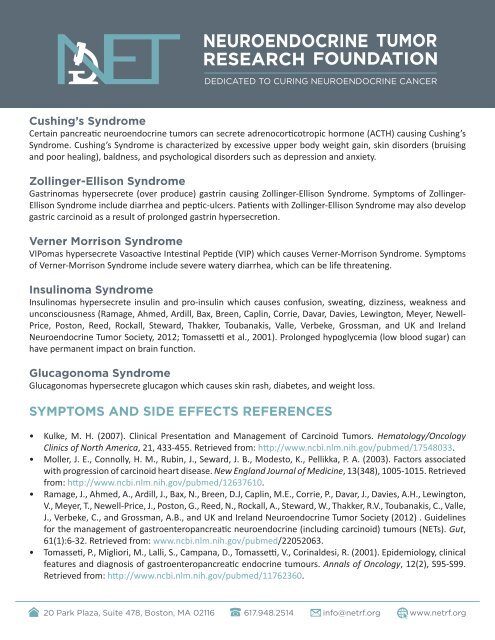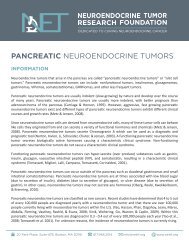PANCREATIC NEUROENDOCRINE TUMORS
Create successful ePaper yourself
Turn your PDF publications into a flip-book with our unique Google optimized e-Paper software.
Cushing’s Syndrome<br />
Certain pancreatic neuroendocrine tumors can secrete adrenocorticotropic hormone (ACTH) causing Cushing’s<br />
Syndrome. Cushing’s Syndrome is characterized by excessive upper body weight gain, skin disorders (bruising<br />
and poor healing), baldness, and psychological disorders such as depression and anxiety.<br />
Zollinger-Ellison Syndrome<br />
Gastrinomas hypersecrete (over produce) gastrin causing Zollinger-Ellison Syndrome. Symptoms of Zollinger-<br />
Ellison Syndrome include diarrhea and peptic-ulcers. Patients with Zollinger-Ellison Syndrome may also develop<br />
gastric carcinoid as a result of prolonged gastrin hypersecretion.<br />
Verner Morrison Syndrome<br />
VIPomas hypersecrete Vasoactive Intestinal Peptide (VIP) which causes Verner-Morrison Syndrome. Symptoms<br />
of Verner-Morrison Syndrome include severe watery diarrhea, which can be life threatening.<br />
Insulinoma Syndrome<br />
Insulinomas hypersecrete insulin and pro-insulin which causes confusion, sweating, dizziness, weakness and<br />
unconsciousness (Ramage, Ahmed, Ardill, Bax, Breen, Caplin, Corrie, Davar, Davies, Lewington, Meyer, Newell-<br />
Price, Poston, Reed, Rockall, Steward, Thakker, Toubanakis, Valle, Verbeke, Grossman, and UK and Ireland<br />
Neuroendocrine Tumor Society, 2012; Tomassetti et al., 2001). Prolonged hypoglycemia (low blood sugar) can<br />
have permanent impact on brain function.<br />
Glucagonoma Syndrome<br />
Glucagonomas hypersecrete glucagon which causes skin rash, diabetes, and weight loss.<br />
SYMPTOMS AND SIDE EFFECTS REFERENCES<br />
• Kulke, M. H. (2007). Clinical Presentation and Management of Carcinoid Tumors. Hematology/Oncology<br />
Clinics of North America, 21, 433-455. Retrieved from: http://www.ncbi.nlm.nih.gov/pubmed/17548033.<br />
• Moller, J. E., Connolly, H. M., Rubin, J., Seward, J. B., Modesto, K., Pellikka, P. A. (2003). Factors associated<br />
with progression of carcinoid heart disease. New England Journal of Medicine, 13(348), 1005-1015. Retrieved<br />
from: http://www.ncbi.nlm.nih.gov/pubmed/12637610.<br />
• Ramage, J., Ahmed, A., Ardill, J., Bax, N., Breen, D.J, Caplin, M.E., Corrie, P., Davar, J., Davies, A.H., Lewington,<br />
V., Meyer, T., Newell-Price, J., Poston, G., Reed, N., Rockall, A., Steward, W., Thakker, R.V., Toubanakis, C., Valle,<br />
J., Verbeke, C., and Grossman, A.B., and UK and Ireland Neuroendocrine Tumor Society (2012) . Guidelines<br />
for the management of gastroenteropancreatic neuroendocrine (including carcinoid) tumours (NETs). Gut,<br />
61(1):6-32. Retrieved from: www.ncbi.nlm.nih.gov/pubmed/22052063.<br />
• Tomasseti, P., Migliori, M., Lalli, S., Campana, D., Tomassetti, V., Corinaldesi, R. (2001). Epidemiology, clinical<br />
features and diagnosis of gastroenteropancreatic endocrine tumours. Annals of Oncology, 12(2), S95-S99.<br />
Retrieved from: http://www.ncbi.nlm.nih.gov/pubmed/11762360.<br />
20 Park Plaza, Suite 478, Boston, MA 02116 617.948.2514 info@netrf.org www.netrf.org
















